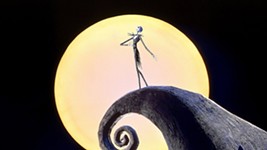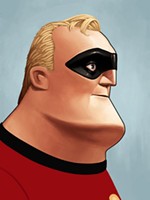Deconstructing 'The Nightmare Before Christmas'
… the day after Christmas
By Brandon Engel, 5:14PM, Thu. Dec. 26, 2013
Believe it or not, it’s been 20 years since the release of The Nightmare Before Christmas.
Its legacy endures as one of the greatest feature-length stop-motion animated films of all time. And while the finished project is something incredible unto itself, the process that went into its construction is equally magical.
A team of more than 100 technicians and artists worked diligently for three years to complete the film. But the inception of the film had come several years earlier. In fact, much of the principle design work had been nearly a decade in the works before the film went into production.
Producer Tim Burton once said in an interview that the film was inspired largely by his love of classic Christmas specials. “Every Christmas you’d watch things like Rudolph the Red-Nosed Reindeer, or The Grinch … those were my favorite holiday specials growing up.” Burton went on to say that when he was working at Disney in the early Eighties, he had designed a project that was “the Grinch in reverse, so to speak, about this character who finds Christmas and loves it and decides to do it himself.”
But the project lay dormant for several years, as Disney executives were worried that the film would be perceived as too strange and dark for younger viewers. Burton eventually persuaded them to push the film into production, but Disney still decided to distribute the film under their Touchstone banner, for fear of tainting the Disney brand.
Although Henry Selick was brought in to direct the film, he attributes the concept, story arc, character design, and overall tone of the film to Burton – even though Burton himself was largely absent from the production of the film itself, as he was preoccupied with directing other projects.
The Danny Elfman score and nearly all of the other preliminary work for the film done by producer Burton was finished before the production itself even began. With the script and music in place (crucial for establishing the timing), the storyboard had to be constructed. A storyboard is a series of static images which map out the narrative sequentially, and also help to establish the composition of shots.
When the time came to begin actually shooting the film, Burton and Selick assembled a team of 13 animators, several camera technicians, and countless other specialists to assist with the fabrication of puppets, sets, and props. Ultimately, well over 200 sets, and hundreds of individual puppets, were constructed. and all of the objects from the film ended up occupying 19 soundstages.
Burton wanted to evoke the illustrative, pen-and-ink aesthetic of artists Ronald Searle and Edward Gorey. Selick said that many of the sets were coated in either clay or plaster, so that artists could go in later and scrape and etch whatever medium so that the environments would have additional linework that would evoke two-dimensional illustration.
Art Director Deane Taylor said that Burton was also highly specific about color. Halloween Town, for instance, had very rigid parameters set for its palette: only black, white, and orange were to be used. The design of Halloween Town evokes early German Expressionist filmmaking – particularly The Cabinet of Dr. Caligari by Robert Weine. Christmas Town, however, bears a remarkable aesthetic similarity to Whoville from the Chuck Jones-directed How the Grinch Stole Christmas, and when we see the “real world,” it's all cookie-cutter houses, and everything is ultra milquetoast – the way Burton has always depicted the suburbs (which, no doubt, owes something to his upbringing in Burbank, Calif.).
Traditionally, fully animated films are shot at 24 frames a second, although there are shortcuts which producers can (and often do) take, especially with animated programs produced for TV. But Nightmare is fully animated, which means that for every second of footage, the puppets on screen had to be posed and photographed 24 times.
While it it will be fondly remembered by fans for a certain whimsical and richly imaginative aesthetic quality, the reality is that the entire process of the film's construction was laborious and deliberate. Does knowing what went on behind the scenes diminish the magic? French puppeteer Philippe Genty once said in an interview that the strength of puppetry is the spectator’s active desire (not merely willingness) to believe that this objects and characters are functioning autonomously.
Judge for yourself though! There have been several reissues and releases in recent years, and if you haven’t seen the film in a while, it bears revisiting. A brand new 20th anniversary Blu-ray recently hit the market, and you can also stream the film in its entirety through sites like DirectTV and Netflix.
A morbid Christmas to all, and to all … a good fright!
A note to readers: Bold and uncensored, The Austin Chronicle has been Austin’s independent news source for over 40 years, expressing the community’s political and environmental concerns and supporting its active cultural scene. Now more than ever, we need your support to continue supplying Austin with independent, free press. If real news is important to you, please consider making a donation of $5, $10 or whatever you can afford, to help keep our journalism on stands.
Marisa Mirabal, Dec. 21, 2017
Richard Whittaker, March 6, 2014
The Nightmare Before Christmas, Tim Burton, Disney, Danny Elfman, animation, Henry Selick, Touchstone









